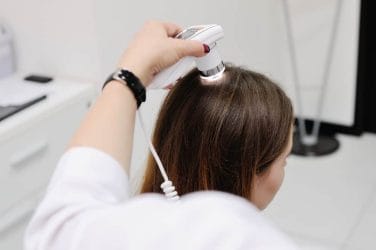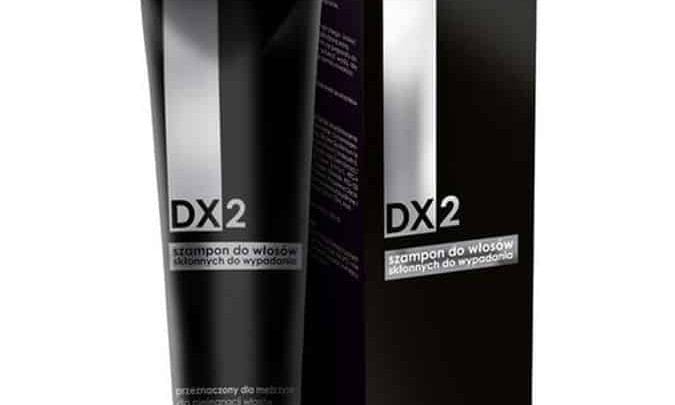
Telogenetic alopecia – causes and symptoms.
Text updated on 11.04.2021
Accelerated and usually difficult to stop hair loss can happen to anyone, regardless of gender, both men and women. There are many reasons for this, sometimes very difficult to diagnose and apply the right treatment that can effectively stop it. Unfortunately, baldness cannot be simply accepted, although in case of men it is a completely natural process that comes with age.
The situation is worse for women. In their case, hair loss almost automatically means some abnormality, a disease developing in the body that remains undetected or negligence of hair and scalp hygiene. So the reaction must be quick, and the first thing to do is to diagnose what kind of baldness we are dealing with. One of the most common, especially in women, is telogenetic alopecia, which untreated can quickly lead to total hair loss.
Contents
Phases of hair growth – what does its life cycle look like

As already mentioned, hair loss in the vast majority of cases should not be a cause for concern, as long as the amount of hair loss is within the norm defined by research, not more than 100 per day. However, before we address telogenetic alopecia itself, its causes, symptoms and treatment, we should learn more about the hair growth cycle associated with this disease.
Our hair grows throughout our lives, but its growth follows a cyclical pattern that is divided into three extremely important phases, which are:
1. growth phase
Also known as anagen, the longest phase, which can last from 2 to 6 years, about 90 percent of our hair grows at the same time. During this time, you can see a lot of activity in each hair follicle responsible for the proper nutrition and growth of the hair connected to it.
2. transitional phase
That is, involutionary phase, also called catagen and in this phase hair bulbs shrink, the production of cells in the disappearing hair matrix slowly ceases and the hair itself begins to die. This phase is much shorter than the previous one, lasting only 14 to 21 days, covering only 1 – 3 percent of hair.
3. resting phase
It is called telogen and it is from it that this variety of baldness gets its name. This is the resting period and in the telogen phase the hair stops growing completely and the hair follicles remain empty and inactive for this time. The old hair becomes keratinized and begins to fall out, which lasts from 2 to 4 months, covering about 15 percent of our hair.
Telogenetic alopecia – symptoms
Defining the concept of telogenetic alopecia in the clearest way, we can say that it is associated with the resting phase of the hair. It occurs when, for various reasons, the number of hairs entering this phase increases, which may reach up to 50 – 80 percent. This is manifested by their increased, visible loss, which results in the appearance of baldness. It does not affect only certain areas of the head, the top or the bends, but the hair falls out evenly, reaching almost 50 percent of the area, which may last for several months or even years in many cases.
Interestingly, telogenetic alopecia can also affect other hairy parts of the body, such as the armpits or the intimate area. In most cases, the disease is painless. However, some patients complain of slight pain, burning or itching of the scalp, which has its medical name trichodynia. If the condition is diagnosed quickly enough, which can be done by a dermatologist or a trichologist, and the appropriate treatment is implemented, the process of hair loss is fully reversible.
Telogenetic alopecia – types and how to make a diagnosis

Now that we know what it is and how this disease manifests itself, it’s time to learn about the causes of telogenic alopecia and its most common types. We will start with them and distinguish its two basic types:
- Acute telogen alopecia, in which the hair falls out quickly over the entire scalp, but the whole process usually begins in the forehead area, gradually progressing further. Hair begins to grow back spontaneously later, which takes about 3 months;
- Chronic telogenetic alopecia, usually accompanying systemic diseases such as lupus erythematosus, with diffuse, very wide baldness lasting for a long time, even more than 6 months.
Telogenetic alopecia – causes of the disease
If a trichologist or doctor wants to correctly diagnose telogenic alopecia the causes that cause it are so varied that it can make it difficult for them to make the right diagnosis. However, this is necessary if an appropriate treatment is to be implemented, which is why various diagnostic methods are used, ranging from a pull test or hair wash to a biopsy. Blood and urine tests, i.e. complex laboratory tests showing, among others, the level of iron or thyroid hormones, also turn out to be very useful.
All causes that lead to the development of telogenetic alopecia cause extension of telogenesis, the resting phase of hair described above:
A diet low in nutrients
Its importance for the body cannot be underestimated, after all, poor diet can ruin the whole health in a relatively short period of time, cause overweight and obesity, it also has a significant impact on the health of hair and scalp. Weakening of the hair itself, as well as hair follicles and hair bulbs, is caused by the lack of appropriate nutrients in the diet. This is why it is essential to have the following nutrients in what you eat:
- complete protein, an ingredient that enables the synthesis of the basic building material of hair, i.e. keratin;
- Vitamin A, also called retinol, is necessary for the proper development and functioning of hair follicles, regulating their work through cell metabolism. It prevents dryness, brittleness and fragility of hair, stops them from falling out;
- B vitamins, including biotin, i.e. vitamin B6 and cobalamin, vitamin B12. It is thanks to them that hair becomes thicker, stronger, weather-resistant and resistant to damage;
- vitamin C, probably the most important for our overall health, an antioxidant whose main task is to remove from the body threatening free radicals. It also regulates the processes of production of collagen, a material co-creating the skin, and other valuable substances, such as iron, deficiency of which may become one of the causes of faster hair loss;
- vitamin D, whose main source is sunlight, which strengthens the immune system and thus also protects us from diseases whose symptom is hair loss, such as hyper- or hypothyroidism or Hashimoto disease;
- Vitamin E, which takes care, above all, of the skin’s health, another antioxidant essential for our body. It moisturises and nourishes the scalp, accelerates the regeneration of damaged scalp cells and the healing of possible wounds or irritations which may have a negative impact on the functioning of hair follicles;
- minerals, and the most important for hair strengthening are zinc, iron, copper and silicon;
- appropriate amount of water, which, according to doctors, should be drunk on average 2 liters per day. If we do not observe this, we risk not only such diseases as kidney failure, but also low skin hydration level, and the amount of hair that starts to fall out will constantly increase.
You also need to be careful when deciding on a weight loss treatment, carefully selecting the components of such a diet. Definitely not allowed are starvation, having a destructive effect on the hair, which not only will fall out, but may also not grow back.
Hormonal disorders
Proper hormone management is another cornerstone of our health and any disorders in the secretion of key hormones also affect the condition of our hair and may lead to telogenetic alopecia. The most important are two hormones, testosterone in men and estrogen in women. The former very often mutates to a harmful form, dihydrotestosterone, DHT, which can irreversibly damage hair follicles. In women, on the other hand, high levels of estrogen benefit their health and appearance by making them strong, thick and shiny. Reduction of this hormone is visible almost immediately, and the hair loses its shine, becomes fragile, brittle and begins to fall out in very large quantities
A very common cause of the telogen variety of alopecia is thyroid problems, disrupting the hormonal balance and all phases of hair growth at the same time. Diseases, such as hypothyroidism, cause immediate hormonal disturbances. This manifests itself, among other things, in a slowing down of the metabolism at the cellular level, which also affects the cells of which the hair is made up. Their structure weakens, they are more susceptible to damage, brittle, dull and grow more slowly than they fall out.
Stress and other nervous tension
We could talk for hours about the negative impact of stress on health, but it is worth emphasizing how it damages hair and causes telogenetic alopecia. There are so many stress factors that it is impossible to list them all, they may be sudden, e.g. a serious disease that destroys the body for years. One of the symptoms of such a strong nervous tension, which can be not only stress but also depression, is alopecia and not only telogenetic, but practically its every variety, including androgenetic and alopecia areata.
Medications taken
Taking medications for other diseases, not related to the treatment of hair loss, it is worth to read the leaflet attached to them in advance, because it may turn out that one of their side effects is hair loss. Such specifications include, among others:
- oral contraceptives having high doses of estrogen in their composition;
- Drugs against blood clots, used for example in the treatment of varicose veins, which contain heparin;
- antiepileptic drugs;
- medicines used for the above mentioned thyroid diseases;
- beta-blockers, medicines used to treat heart and circulatory diseases.
Other causes of telogenetic alopecia
Among the many other causes that may become the cause of alopecia associated with the hair growth phase, it is worth mentioning:
- The effect of strong chemical compounds contained, for example, in daily hair care cosmetics, shampoos, conditioners or dyes;
- anaemia, a disease, in which the body is unable to absorb iron properly;
- inflammatory conditions with high fever;
- other diseases, including infectious diseases, HIV virus infection, liver or kidney failure, autoimmune diseases, venereal diseases;
- Skin diseases, which can also cause baldness, even simple acne, or seborrheic dermatitis, which is more difficult to treat;
- poisoning, especially with heavy metals such as lead.
Telogenetic alopecia – recommended treatments

As already mentioned, telogenic alopecia is a disease that can be fully cured, inhibit the loss of too much telogen hair and cause their regrowth. The most important issue is to regulate the abnormalities of the hair resting phase, and until recently strong pharmaceuticals containing minoxidil were used for this purpose, undoubtedly effective, but also causing many dangerous side effects.
Therefore, it is better here natural preparations, based on safe to use active ingredients, such as Folisin, in which we find only plant and natural ingredients, not causing any side effects.
Counteracting the negative effects of telogenetic baldness, you should also remember about:
- reducing stress, in which herbs such as ashwagandha can also help;
- the mentioned change in diet for a healthier and full of nutrients;
- restoring the body’s hormonal balance;
- proper hair and scalp hygiene, with the use of cosmetics suited to their type and the natural pH of the skin;
- natural treatments that strengthen weakened hair, hair follicles and hair bulbs, also based on herbs and other plants with proven healing properties;
- in some cases, the use of mesotherapy treatments, carboxytherapy or LED laser treatment, which can be carried out for example at the trichologist’s office.



